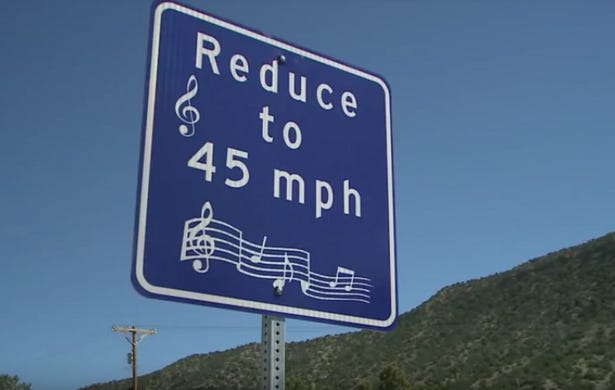
In the middle of rural Japan, in the heart of Fukushima prefecture, lies a scenic stretch of road.
A road sign, adorned with a large musical note, along with musical notes on the ground, alert drivers that something’s just a little bit different around here.
As cars drive over the road, specially-constructed grooves play a song, out loud and clearly audible to passengers and anyone nearby.
And what song is it this mysterious Japanese road plays, you might ask?
Japan’s national anthem?
Some J-pop theme?
NOPE!
How about the state song of West Virginia?
You read that correctly: Take Me Home, Country Roads plays as you drive along Japan’s Tadami River.
Turns out there are musical roads all over the world, all created using the physics of grooves of certain lengths in the road, spaced a certain way, generating intentional and tuned sound.
The first known musical road was created in Denmark back in 1995, and hilariously called The Asphaltophone.
Much more recently, an enterprising engineer at Auburn University created “War Eagle Road,” a musical road that welcomes football fans to campus by playing the school’s theme song.
Consistently, these musical roads are created with one overarching theme in mind:
Managing speed.
Take Route 66, one of the earliest highways in the United States and one that stretches all the way from Illinois to California.
In New Mexico, one particular stretch of Route 66 was associated with numerous accidents and fatalities related to driving too fast.
The solution? Create a musical road that plays, in this case, America the Beautiful…as long as you drive over it at 45 miles per hour.
The idea of using audio to influence behavior is not new.
Perhaps the most notable recent example is Muzak, otherwise known as “elevator music.” Instrumental and reduced versions of popular music were used specifically in elevators to calm the nerves of people anxious about getting into them, for perhaps the first time, many decades ago.
Retail environments, manufacturing plants, and other environments associated with stress were quick to pipe in this music, in order to create more palatable and often more productive environments.
The music could not be distracting - it had to sit beneath the conscious surface. This meant no words, and it meant a volume in a pre-defined range that would not arouse awareness to most people. It was down to a science.
And like many things that previous generations had down to a science, our current culture has vilified it, written it off, and forgotten about it completely.
There are important lessons for any company in the voice technology / conversational AI space to take from all of this.
How can intentional audio samples, whether music or something else, augment your offering? How can they be used to shape behavior around your product?
Voice interfaces, whether for banking, healthcare, hospitality, or elsewhere, need not be limited to the reactive answering of questions. Conversational AI platforms built for contact centers and otherwise need not focus just on keying in on customer context to create efficiency, but can strive for something greater.
Their own musical road.
As announced this week: over 100 media and trade associations will be part of the 2500 attendees at Project Voice 2023.
The Connected Vehicle Trade Association and Restaurant Business Magazine join Voicebot.ai, Open Voice Network, the Metaverse Standards Forum, PYMNTS.com, the New York Times, Polygon, & many more.
We are building the 2023 version of our namesake event from the ground up to be the singular best experience this young voice tech / conversational AI space has seen.








